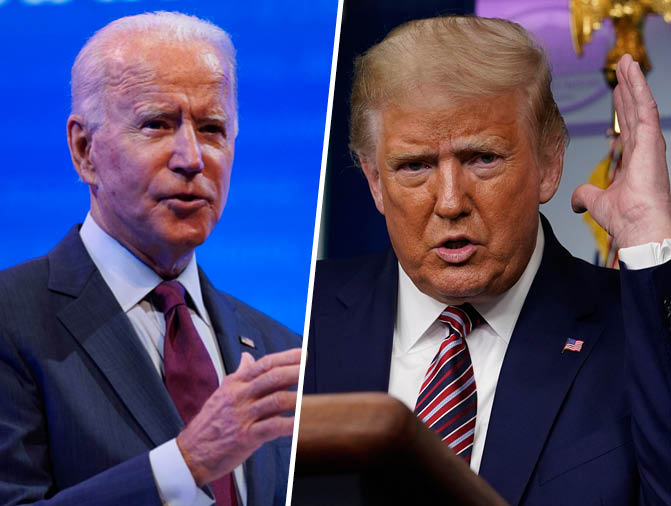Four weeks ahead of the US presidential election, most polls report a 10-point Biden lead in popular vote intentions. But what is, in detail, behind such lead? In an age of issue competition, where vote choices are more and more structured by specific issues (a good example being Trump winning Rust Belt states in 2016 with his promise to bring back jobs to the US), what are the issues where Biden enjoys a competitive advantage? What are Trump’s?
Answers come from the exclusive CAWI survey we at CISE ran on a sample of the US voting age population (N=1,550; sample stratified by sex-age combination, education, US region, ethnicity) between Sep 28 and Oct 5. Part of the larger Issue Competition Comparative Project (ICCP) which has already covered eight European countries since 2017 (with first scientific results published few months ago), the survey includes a rich set of measures (position, priority, credibility) on a large number of issues (34). We deeply thank Morris P. Fiorina from Stanford University and Mark N. Franklin from Trinity College Connecticut for their key contribution to issue selection and survey question wording.
In sheer terms of voting intentions, our results are in line with other polls, with a 10-point lead for Biden (53 vs. 43%, with cases weighted by sex-age combination, education, US region, ethnicity, and 2016 presidential vote recall). But let’s see details about specific issue areas, listing most salient first.
Non-partisan goals

First and foremost, we framed nine issues as non-partisan, shared goals. For these goals, we asked respondents about whether they assign a high priority to each goal, and whether they consider the two candidates credible to achieve the goal (both candidates or no candidate could be selected).
In general, these non-partisan goals are those that are most salient to respondents (the “saliency” percentage reported for each goal indicates how many respondents report a high priority for that goal), with saliency figures reaching and passing 80%. Regarding leader credibility patterns:
– Biden shows a quite large (10 points or more) credibility advantage on four issues, which include the two most salient (fighting COVID, with a 15-point advantage, and providing leadership, 10 points) and the two least salient of the group (14 points on improving public schools, 13 on showing respect for veterans).
– Goals of intermedate saliency (albeit still very salient, i.e. around 80%) show instead much more balanced credibility patterns, with very small Biden leads. Trump only slightly leads on boosting economic growth. In general, these goals show a clear Biden advantage (unsurprising, given that voting intentions report a 10-point lead).
COVID
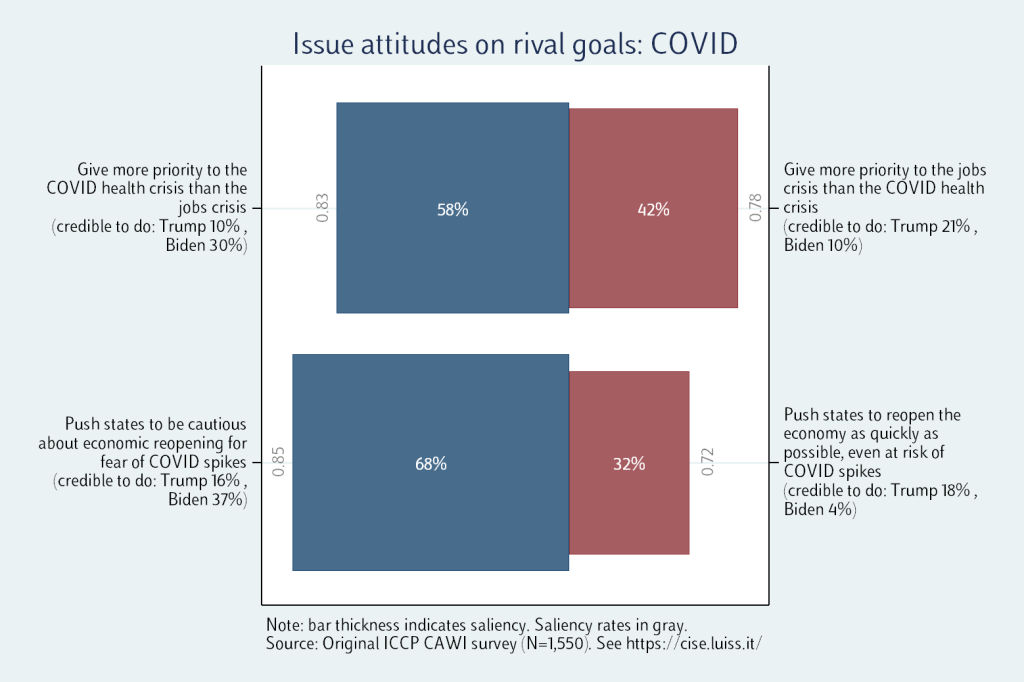
Coming to divisive issues, we now list most salient issue areas first, and this unsurprisingly leads us to listing the COVID crisis first. Here we asked first a general question on the public health vs. economy trade-off, followed by a more specific question on economic reopening.
– Results for both questions point towards a priority for health over the economy: 58 vs 42% in terms of public health priority, becoming 68 vs 32% when it comes to pushing states about being cautious on reopenings.
– Interestingly enough, this majority pushing for more caution is also more mobilized. The 58% prioritizing health over jobs has a saliency rate of 0.83 (in gray) indicating that 83 in 100 of them assign a high priority to this goal. This value is slightly lower (0.78) for those prioritizing the job crisis. But this saliency gap becomes larger on state reopening policy, where the 68% majority has a .85 saliency rate, vs. the .72 saliency rate among those 32% wanting states to reopen quickly. In other words, the preferences of the two groups are of different intensity.
– Finally, it’s important to look at credibility figures. Rival orientations on these two items clearly have a partisan color, with Biden enjoying higher credibility on the public health side, and Trump on the economy side. However, the credibility advantage of Biden on “his” side is larger (respectively a 20- and 21- point credibility gap) than Trump’s on his side (respectively 11 and 14 points).
Law and order
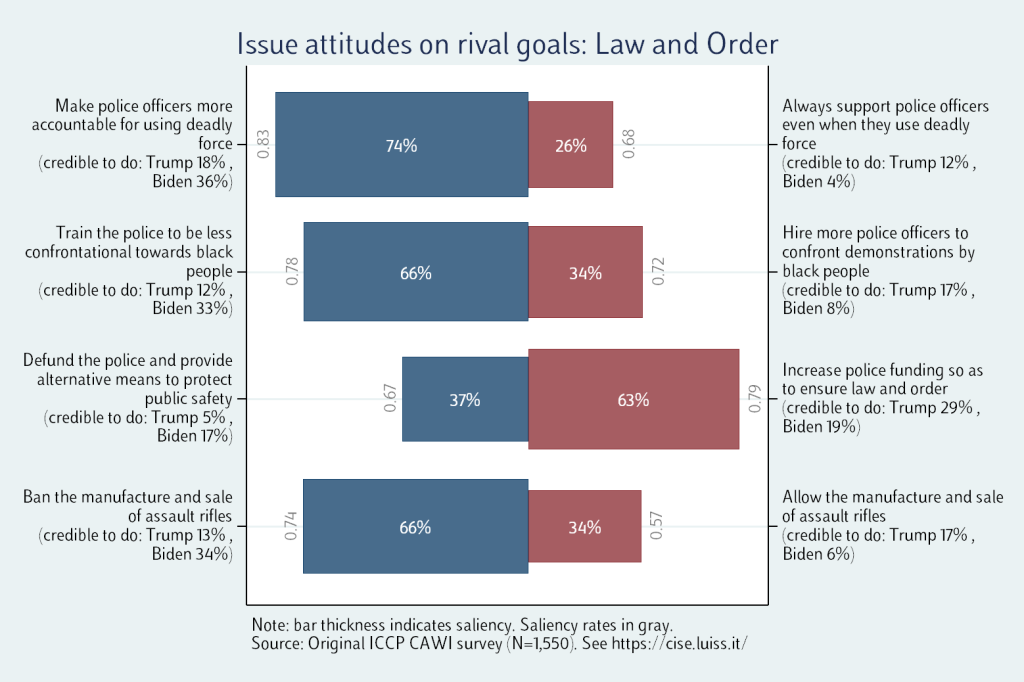
Law and order is the issue area ranking second in terms of overall saliency. We asked four questions relating to police officers accountability, training, and funding, plus a question concerning the restrictions on the manufacture and sale of assault rifles.
– Results show that respondents clearly support policing that is more accountable (74%) and less confrontational towards black people (66%); bu at the same time, the sample is clearly against defunding police forces (63%, vs 37% supporting defunding). Furthermore, a large portion of the sample supports the ban on the manufacture and sale of assault rifles (66%).
– All these four objectives are quite salient. On all four issues, the leading side is also more mobilized (i.e. with a higher internal saliency rate). Largest mobilization gaps across rival sides occur on assault rifles ban (.17 gap for banning rifles vs. not banning them) and more accountable policing (.15 gap).
– These issues have a clear partisan color. Biden enjoys a higher credibility on accountable (18-point gap) and less confrontational (21-point) policing , and on assault rifles ban (21-point). A combination of high popular support and high priority of these policy objectives, should thus favor Biden. On the contrary, Trump is perceived more credible when it comes to increasing funds to the police to ensure law and order (10-point gap). Also in this case, a combination of large support and high priority could make this issue electorally rewarding for Donald Trump.
Abortion

Abortion is an ongoingly salient issue in American politics, and inevitably also part of this campaign.
– Not surprisingly, the issue is particularly divisive, with a closely divided sample: 54% supports the rights of women to choose in pregnancy over the protection of unborn life through every means available (46%).
– On both sides we find a relatively high saliency, with a slightly higher level for protection of unborn life (0.75 vs. 0.70).
– In terms of credibility, results are in line with the partisan color of the issue. Joe Biden is much more credible than Trump in protecting the rights of women to chose in pregnancy (27% Biden vs 7% Trump); while Donald Trump is more credible in protecting unborn life (23% Trump vs 11% Biden). Still, the credibility advantage of Biden over Trump in protecting women’s rights is higher compared to Trump’s on “his” policy objective.
Economy
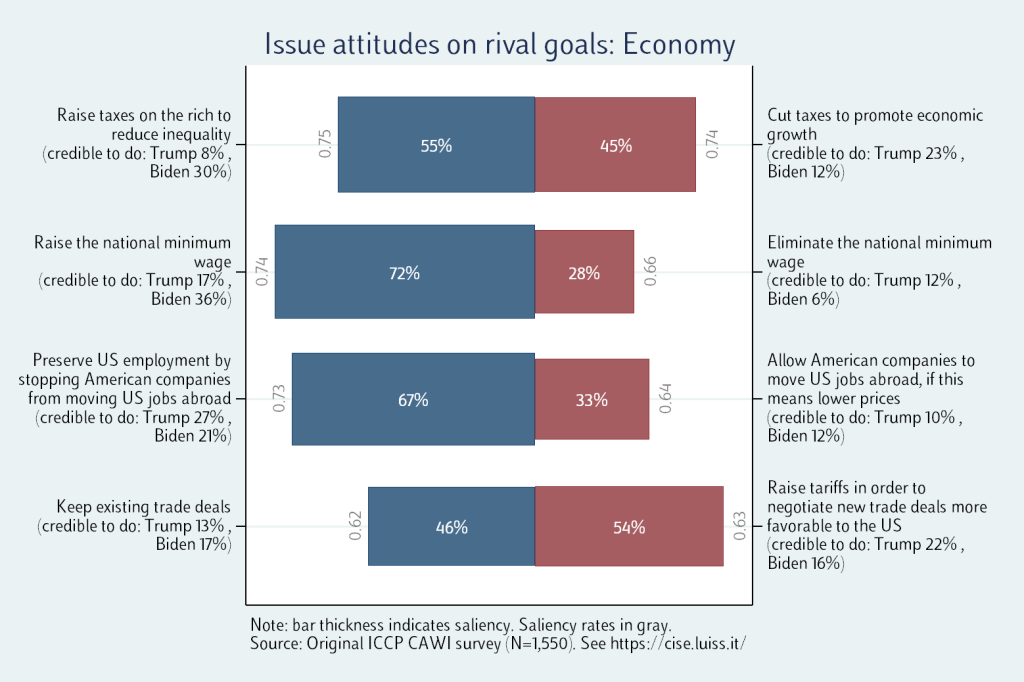
The economy, albeit on lower saliency levels, is still among the top priorities of our respondents. And we can reasonably expect that economic issues will have a weight on voters’ behaviour.
– A majority of respondents supports classic liberal goals such as raising taxes to reduce inequality (55% vs 45%) and raising the national minimum wage (72% vs. 28%). Large support is also enjoyed by a protectionist measure such as protecting US emplyment by stopping US companies from moving jobs abroad (67%); also, 54% prefers to raise tariffs in order to negotiate new trade deals with international partners.
– Across the four issues, mobilization appears as relatively symmetrical across rival positions, excepts for minimum wage and protection of US jobs, with larger saliency gaps between rival sides.
– On taxes and minimum wage, Joe Biden is considered to be more credible compared to Donald Trump (30% Biden vs 8% Trump on taxes; 36% Biden vs 17% Trump on the national minimum wage). However, Donald Trump is clearly favored on the protection of US employment and on the increase of tariffs to negotiate better trade deals at the international level. Both these policy objectives meet the support of the majority of US voters (respectively 67% and 54%) and show a credibility advantage for Trump. However, such advantage is not large (6 percentage points in both cases); and, while protection of US employment has a relatively high saliency, the same is not true for raising tariffs (saliency rate is 0.63).
Welfare
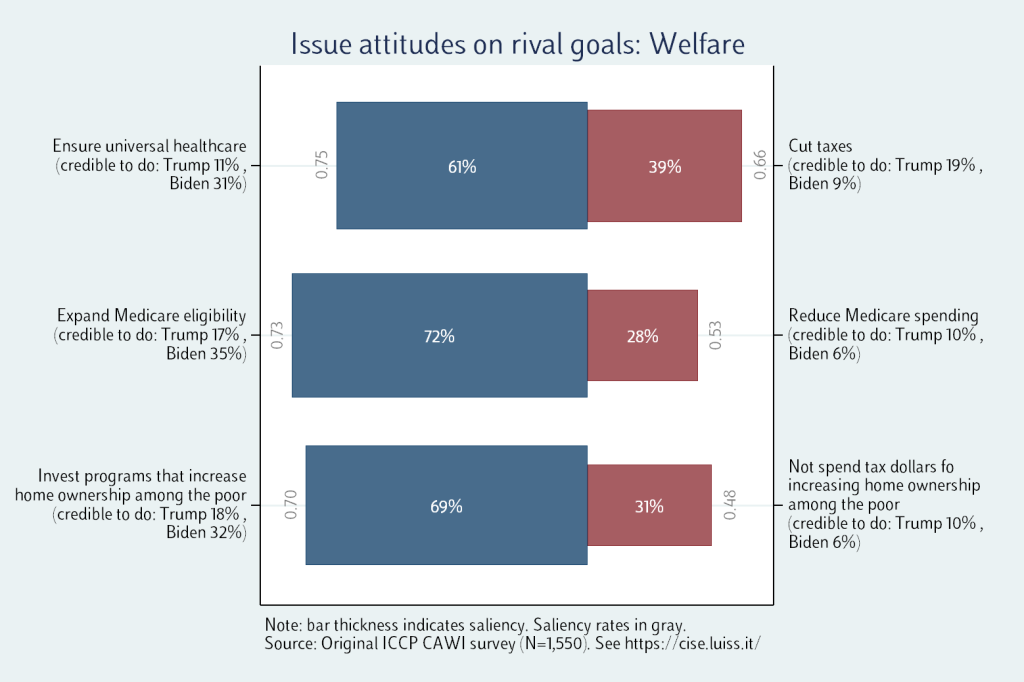
If the economy is a competitive issue area, welfare appears much less so. Indeed, respondents largely espouse progressive positions on welfare policies, in fact favoring Joe Biden.
– 61% of respondents want universal healthcare to be ensured, against 39% of voters who instead prefer to cut taxes even at cost of cutting resources for universal helthcare. Consistently, 72% of voters prefers to expand Medicare eligibility, rather than cutting Medicare spending. Finally, 69% of voters supports an increase of investments to favor home ownership among the poor.
– All these three objectives are highly salient for those who selected them. Among supporters of universal healthcare, salience rate is 0.75; while it is only slighly lower among supporters of expansion of Medicare eligibility (0.73) and of investments to increase home ownership among the poor (0.70).
– Finally, on all these three objectives, Joe Biden is widely considered as the most credible candidate. The credibility advantage of Biden is equal to 20 percentage points on universal healthcare; 18 percentage points on exapansion of Medicare; and 14 percentage points on the investments for increasing home ownership among the poor.
Environment
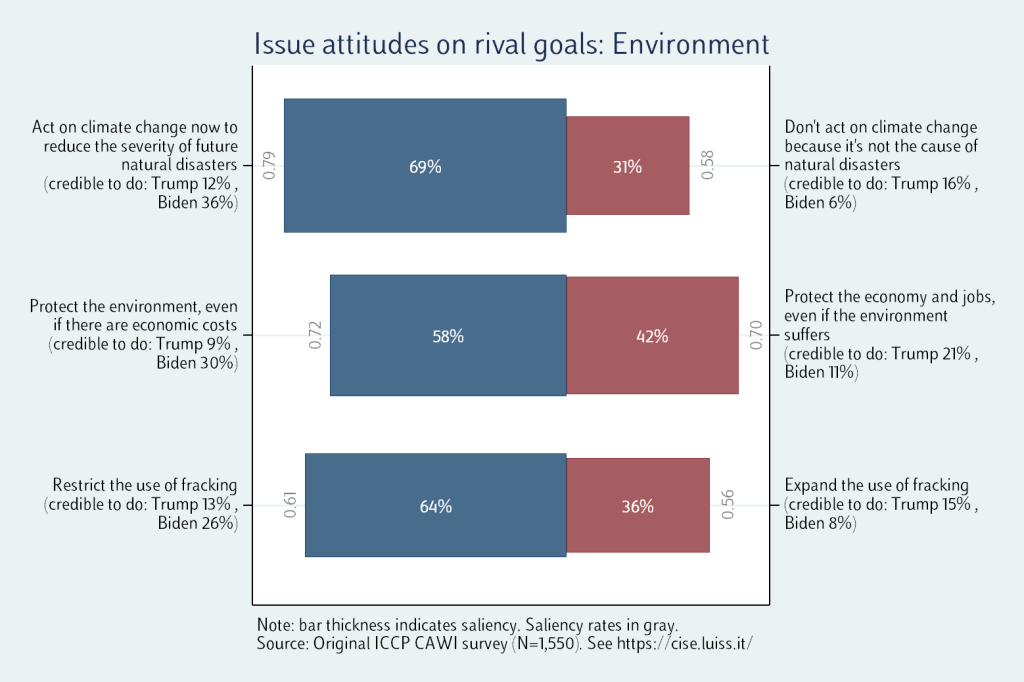
– The environment as well is a promising issue area for Joe Biden. Even in this case US respondents lean towards more progressive positions, supporting the defence of the environment, even at cost of economic consequences. 69% call for an immediate action on climate change to reduce the severity of future natural disatsers such as floodings and fires. Along the same line, 58% of voters support the protection of the environment over the protection of the economy; and 64% support reducing the use of fracking.
– Out of the three policy objectives just mentioned, two in particular enjoy a relatively high salience: action on climate change (saliency rate is 0.79) and environmental protection (0.72). On both these issues, Biden has a clear credibility advantage over Trump: 24 and 21 percentage points respectively. Thus, the combination of large support, relatively high priority, and credbility advantage, make these issues potential sources of mobilisation of a pro-Biden electorate.
– As for the use of fracking, although its limitation is supported by 64% of the electorate, still the policy objective is not particularly salient (neither for the electorate at large nor for those who preferred a restriction on the use of fracking -salience rate here in fact is 0.61). Furthermore, although Biden is still considered more credible than Trump on this objective, his advantage here is less pronounced compared to the other two policy objectives considered above (indeed his credibility advantage on fracking is still 13 percentage points).
Foreign policy and defence
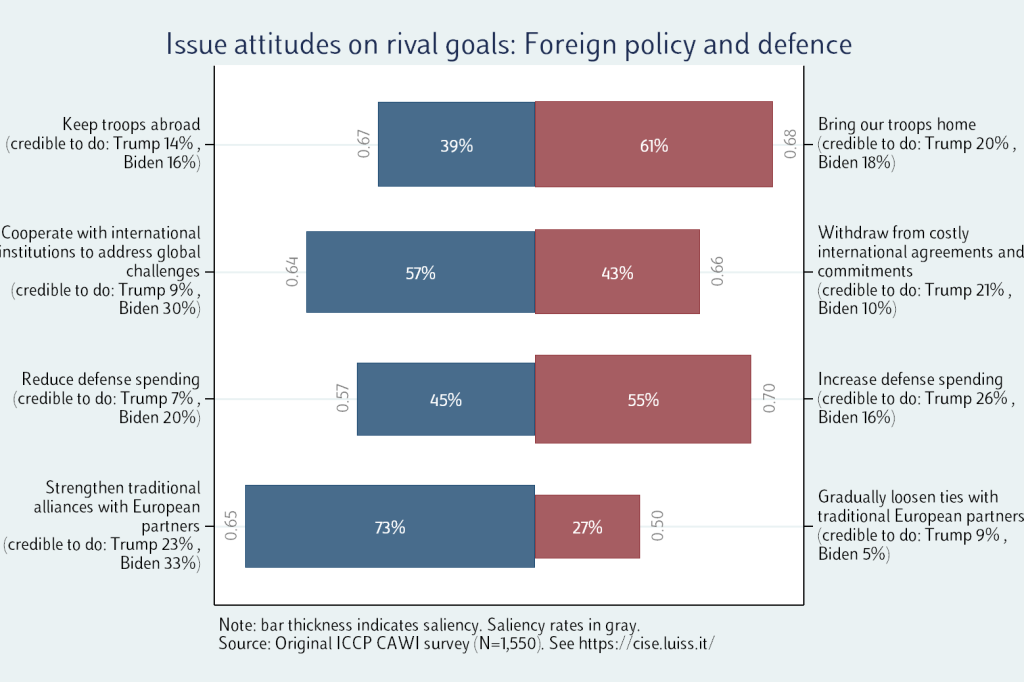
– Although relatively less salient compared to the previous issue areas, foreign and security policy represents a more competitive issue arena. Looking at respondent opinions, we find a mix of progressive and conservative stances. On the conservative side, a majority supports both the retreat of US troops from abroad (61%) and the increase of defence expenditures (55%). On the progressive side, instead, we observe a majority of voters favoring multilateralism (57%) and traditional alliances with European partners (73%).
– For the two conservative goals (bring our troops home and increase defence spending), salience rate is respectively 0.68 and 0.7. For the two progressive goals (multilateratelism and strengthened relations with EU partners), instead, salience rate is lower, respectively 0.64 and 0.65. This means that voters who selected conservative goals could be more likely to be mobilized on these issues, compared to voters supporting the two progressive goals.
– This configuration could yield an electoral advantage for Donald Trump. Indeed, on both conservative goals, Trump holds a credibility advantage over Biden. However, this is tiny on bringing back US troops (2-point gap), while larger (10-point) on defense spending. Looking at more liberal goals, instead, Biden enjoys a strong credibility advantage (21 points on multilateralism and 10 points on US-EU relations). However, given the relatively low salience of these two policy goals for those who selected them, voters could be hardly mobilized on these issues.
Racial and immigration issues
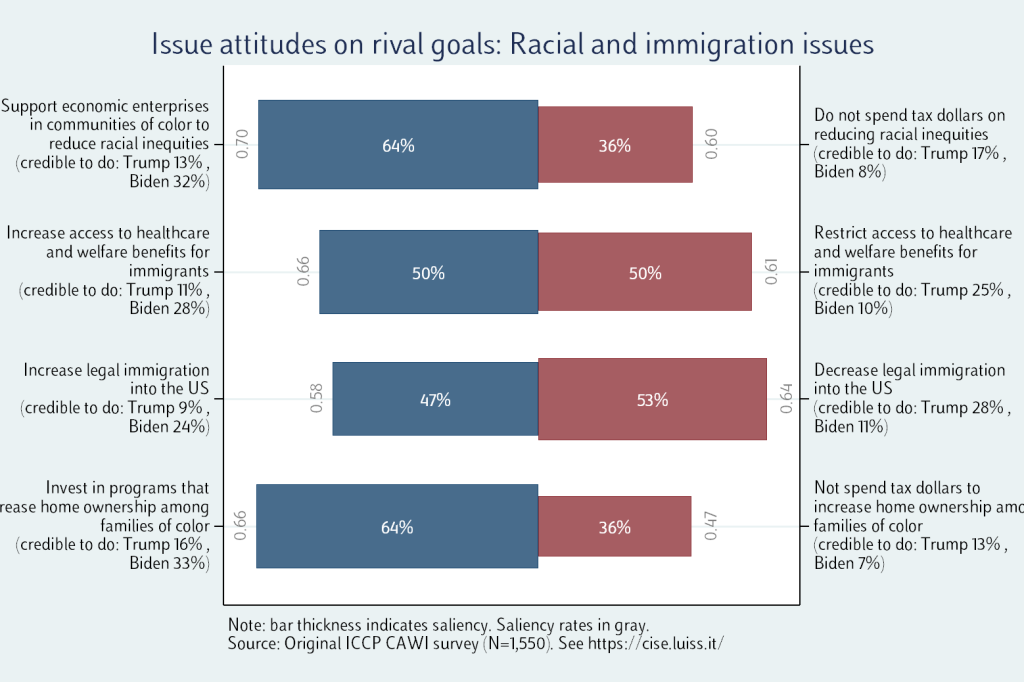
– Issue preferences and priorities on racial issues and immigration give us a complex picture. On issues which are specifically related to immigration, the US electorate appears substantially split into two halves: a progressive one, supporting the access to healthcare benefits for immigrants (50%) and the increase of legal immigration into the US (47%); and a conservative one, which instead is against the increase of access to healthcare and welfare benefits for immigrants (50%) and which supports the decrease of legal immigration into the US (53%). As a consequence, the configuration of issue salience and patterns of credibility on these two issues reflect this progressive-conservative divide. On the progressive pole, we can observe that saliency rate on the increase of access to welfare benefits for immigrants is higher than on the increase of legal immigration; on the conservative pole, instead, the opposite is true. And the two candidates enjoy similar, symmetrical credibility gaps on their respective pole. This is new for this area: while on most issue areas Trump’s advantage on “his” conservative side was lower than Biden’s on “his” progressive side, here both candidates, in their respective sides, hold a solid credibility advantage. This might be a key issue for Trump.
– The picture is different when we come to issues referring to US communities of color (racial issues). We asked, in particular, two questions and the results we get are more neatly defined: 64% are in favor of programs of investments to support both economic enterprises and home ownership in communities of color. And, among these, both policy objectives have a relatively high salience. The saliency rate is in fact 0.70 and 0.66 respectively (which is in general higher compared to saliency rates for immigration issues, both on the conservative and progressive poles). Finally, on both these policy objectives, Biden hold a strong credibility advantage over Trump (19 and 17 percentage points respectively).
Conclusion. Biden leading, but Trump has favorable issues too
Four weeks ahead of the election, our results show how Biden’s lead is structured and defined by his competitive advantage on many issues, especially as more liberal positions tend to enjoy majority support on many issues on our sample. However, several key issues appear from our data that could play well for Trump: and it must be stressed that the secret of a winning campaign is in precisely picking and emphasizing only those issues that play in the candidates’ advantage. As a result, these data might indeed suggest what will be the top priorities of campaigns by both candidates in the coming weeks.
